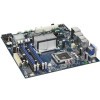- Qualcomm Launches Snapdragon 4 Gen 2 Mobile Platform
- AMD Launches Ryzen PRO 7000 Series Mobile & Desktop Platform
- Intel Launches Sleek Single-Slot Arc Pro A60 Workstation Graphics Card
- NVIDIA Announces Latest Ada Lovelace Additions: GeForce RTX 4060 Ti & RTX 4060
- Maxon Redshift With AMD Radeon GPU Rendering Support Now Available
Intel Desktop Board DG45ID

We’re taking a look at Intel’s first attempt at a full-featured media center motherboard, the DG45ID. It’s also our first look at their new G45 Express chipset, which promises to finally bring DX 10 support and hardware-accelerated HD video playback to their integrated graphics offerings. Can the DG45ID prove itself a worthy choice for your HTPC?
Page 4 – Test Machine Specs and Methodology
At Techgage, we strive to make sure our results are as accurate as possible. Our testing is rigorous and time-consuming, but we feel the effort is worth it. In an attempt to leave no question unanswered, this page contains not only our testbed specifications, but also a fully-detailed look at how we conduct our testing.
If there is a bit of information that we’ve omitted, or you wish to throw off recommendations or suggest changes, please feel free to shoot us an e-mail or post in our forums.
When preparing our testbeds for any type of performance testing, we follow these guidelines:
- The OS installation is left as basic as possible, with important updates applied.
- Required drivers from the motherboard CD-Rom are installed. Non-critical applications are omitted.
- We do not install a virus scanner, firewall or any other security application.
- Scrap files from previous testing are cleaned up; recycle bin / trash is emptied.
- Internet is disabled via software driver.
- Computer has proper airflow and room temperature of 80°F or less.
- Hard-drives affected by testing are defragged with Diskeeper 2008 prior to each fresh run.
No hardware during our performance reviews is changed during testing, except for the product-type being reviewed, of course. Our current configuration is as follows:
|
Component
|
Model
|
| Processor |
Intel Core 2 Duo E7200 (Wolfdale 45nm, 2.53GHz)
|
| Motherboard |
Intel DG45ID (Intel G45-based, Driver 9.0.0.1009)
ASUS P5E-VM HDMI (Intel G35-based, Driver 18.11) |
| Memory |
OCZ 4GB DDR2-800 Reaper HTC (DDR2-800 5-5-5-15)
|
| Video |
Intel GMA X3500 (G35 GMCH, Driver 18.11)
Intel GMA X4500HD (G45 GMCH, Driver 7.15.10.1545) ASUS EN9600GT Silent 512MB (NVIDIA 174.53) |
| Audio |
Onboard HD Audio, ITC Codec
|
| Storage | |
| Power Supply |
PC Power & Cooling Silencer 500
|
| Chassis | |
| Cooling |
Intel Stock Heatsink, Interior Airflow
|
| Et cetera |
For our testing, we use Microsoft Windows Vista Ultimate 64-bit. We’ve chosen to stick to a 64-bit Windows because throughout the past year of usage, we find it to be much more stable than the 32-bit counterpart.
-
Windows Vista Ultimate 64-bit
- Windows is up to date via Windows Update (as of September 20, 2008).
- Before testing begins, the screensaver and all power-related options are disabled.
- Welcome Center and UAC are disabled.
- A recent NVIDIA driver for the 9-series reference discrete GPU is used (174.35).
Once we set up our OS’, nothing changes unless we revamp our entire methodology.
Gaming
In an attempt to deliver accurate results, games that we test with are played through manually, with the average FPS recorded with the help of FRAPS 2.9.4. In our personal tests, we have found that manually benchmarking games is the best way to deliver accurate results, since time demos rely heavily on the CPU.
In order to deliver the best results, each title we choose is explored to find the best possible level for our benchmarking. Once a level is chosen, we play through in order to find the best route, and then in future runs, we stick to that route as close as possible. We are not robots, so we cannot make sure that each run is identical, but they will never be far off from each other. As we see in our results, scaling is good, so we are confident that our methodology is a good one.
Half-Life 2: Episode Two
In this article, we’ll be testing Half-Life 2: Episode Two. Please note that the settings used for testing with IGPs are different than those we use when testing systems based on discrete graphics processors. IGPs typically lack the oomph to tackle antialiasing or high levels of anisotropic filtering.
We also eschew our typical 2560×1600 mode testing, since there’s no point in making the integrated graphics processor struggle needlessly at resolutions that you’re not likely to attempt to run on an integrated-graphics motherboard. While we attempt to test each game at a resolution of 1680×1050 (which is often far too demanding on many IGPs, and usually unplayable), for this review we’ll be testing the game at a resolution of 1280×1024 pixels – for reasons we’ll explain later in the article.
|
1280×1024
|
 |
Call of Duty 4: Modern Warfare
To further put the motherboard’s integrated graphics core to the test, we run through a level of Activision’s Call of Duty 4: Modern Warfare. CoD4 is run at a resolution of 1680×1050 pixels, which we feel is the highest reasonable resolution to attempt with an IGP, and corresponds to the native resolution of most 20″-22″ widescreen monitors.
|
1680×1050
|
 |
On the next page, we’ll kick off our results with SYSmark 2007 Preview.
Support our efforts! With ad revenue at an all-time low for written websites, we're relying more than ever on reader support to help us continue putting so much effort into this type of content. You can support us by becoming a Patron, or by using our Amazon shopping affiliate links listed through our articles. Thanks for your support!




